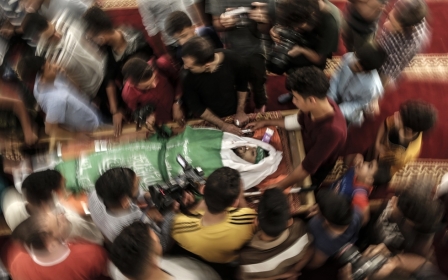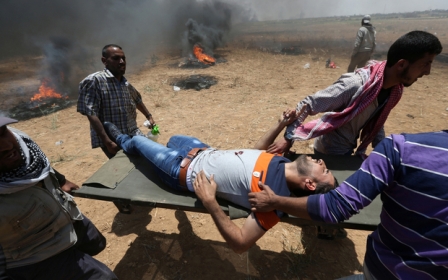Israeli forces shoot Canadian doctor in Gaza

Israeli forces shot a Canadian doctor in the leg on Monday as he treated wounded Palestinians protesting in Gaza and killed his medical assistant.
Dr Tarek Loubani, who works as an emergency physician in London, Ontario, and teaches at Western Ontario’s medical school, said he was wearing a distinctive green surgeon’s scrubs and was standing with several paramedics decked in bright orange vests that signify their status as medical workers.
“I am very seasoned about not being shot at. I know where to stand. I know where to be. I know how not to get shot,” he told the Canadian newspaper The Globe and Mail.
“Snipers don’t reach me because of mistakes. I did everything right. We were all huddled. It was quiet at the exact moment I got shot. The bullet went through my left leg, through my right leg out and hit the ground,” Loubani added.
Loubani’s medical assistant, Musa Abuhassanin, was shot and killed by Israeli forces.
“There was relatively heavy fire that was going on. He was wearing a high visibility jacket. It was clearly marked. He was shot in the chest,” Loubani said.
“They couldn’t remove him. They couldn’t recover him for about 30 minutes until finally they dragged him to a blind spot and then dragged him down a hill and took him to the hospital in a civilian vehicle. He died before he got to the hospital,” he said.
Israel has targeted health workers since the protests in Gaza began on 30 March. According to the World Health Organisation, there have been 229 attacks against medical personnel that have helped treat wounded Palestinians.
Doctors Without Borders issued a statement describing chaotic scenes at Gaza's hospitals, condemning Israel’s attacks on medical workers on Monday.
“In one of the hospitals where we are working, the chaotic situation is comparable to what we observed after the bombings of the 2014 war, with a colossal influx of injured people in a few hours, completely overwhelming the medical staff. Our teams carried out more than 30 surgical interventions today, sometimes on two or three patients in the same operating theatre, and even in the corridors,” the statement read.
Israel has implemented a debilitating blockade on Gaza for nearly a decade, which has crippled the coastal's hospitals, and the recent protests have, in turn, greatly consumed their medical supply stock.
The Ministry of Health in Gaza said 27 percent of the drugs and 40 percent of “medical disposals” were consumed on Monday alone to treat the wounded. UN OCHA said one hospital consumed a month’s amount that day as well.
Hospitals in Gaza are "on the brink of collapse," according to AIDA, an umbrella group of more than 80 international non-governmental organisations operating in Palestine.
They are “unable to deal with the vast number of injured as a result of a decade-long blockade and insufficient electricity and medical supplies and equipment,” said AIDA.
“Due to the near impossibility of obtaining a medical referral for surgery outside the Gaza Strip, 21 Palestinians injured during demonstrations have so far had limb amputations since 30 March,” AIDA added.
On Tuesday, Nickolay Mladenov, the UN Special Coordinator for the Middle East Peace Process, told the Security Council that Gaza's fragile infrastructure, including lengthy electricity blackouts, required immediate action to be taken.
"Starting tomorrow, the United Nations, together with international partners will need to focus and redouble efforts to implement projects that will have an immediate impact on improving the electricity, water and health situation as a matter of urgency," he said.
Middle East Eye propose une couverture et une analyse indépendantes et incomparables du Moyen-Orient, de l’Afrique du Nord et d’autres régions du monde. Pour en savoir plus sur la reprise de ce contenu et les frais qui s’appliquent, veuillez remplir ce formulaire [en anglais]. Pour en savoir plus sur MEE, cliquez ici [en anglais].




